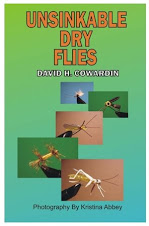1. Hook size 8-12 - 4x long light wire - wrap shank with 6/0 olive thread
2. Tie in black foam for egg sack
3. Slide heat shrink(HS) tubing colored green with ink over shank
4. Insert brown mono in tubing for antana and tails
5. Use iron to shrink tubing at rear
6. Tie in HS and work thread up shank over HS lightly about 1/3 lenght of shank
7. Tie in gray ruber leg on one side then the other
8. Pinch two legs holding them to HS and work thread about 2/3 lenght of shank
9. Tie in legs tightly compresses HS
10. Work thread up to head, use iron to shrink HS at head
11. Tie in 3 wings*
12. Tie in gray foam to form head
13. Tie in front legs
14. Tie in yellow foam to help visibility
15. Straighten/trim tails and anatana with iron - seal with head cement
2. Tie in black foam for egg sack
3. Slide heat shrink(HS) tubing colored green with ink over shank
4. Insert brown mono in tubing for antana and tails
5. Use iron to shrink tubing at rear
6. Tie in HS and work thread up shank over HS lightly about 1/3 lenght of shank
7. Tie in gray ruber leg on one side then the other
8. Pinch two legs holding them to HS and work thread about 2/3 lenght of shank
9. Tie in legs tightly compresses HS
10. Work thread up to head, use iron to shrink HS at head
11. Tie in 3 wings*
12. Tie in gray foam to form head
13. Tie in front legs
14. Tie in yellow foam to help visibility
15. Straighten/trim tails and anatana with iron - seal with head cement
* Link to making wing materal - https://unsinkableflies.blogspot.com/2012/02/making-fly-wing-material-fly-tying.html
Skwala Facts and Rules
Skwala's are interesting flies for several
reasons. First of all, they are the first substantial dry fly of the year
not only in size 1 to 1-1/4 inch in size but quantity. Because of this
fish, often big, that are hungry from a long winter make for good dry fly
fishing opportunities. In addition, streams and rivers have fairly low
flows with the ideal water temperature being 45 to 48F degrees although
you may see them in water as cold as 40 to 42F depending on the amount of sun
and radiational heating from the previous day.
The flies
crawl out on the bank in the morning, mate, and the females return to the water
in the afternoon to lay eggs. The females return to the water often
swimming rather than flying and are generally found in slower speed pools on
the edges in water that is only at the most two feet deep and no more than 3-5
feet from shore.
Skwala Fishing Rules
1. Fish
in the afternoon - water temp of at least 42F (45-48F ideal)
2. Fish
slow speed water - no faster than you can walk
3.
Watch for dry flies on the water or ground - if none nymph
4.
Hatches are often small - watch for rising fish
5. Run
a dropper below your dry fly
6. Use
delicate presentations - no hard splashes
7. Look
for slow, clean, and quite drifts or twitch your fly in surface film or foam
8. Use
a dry fly that floats well and is not prone to sinking









